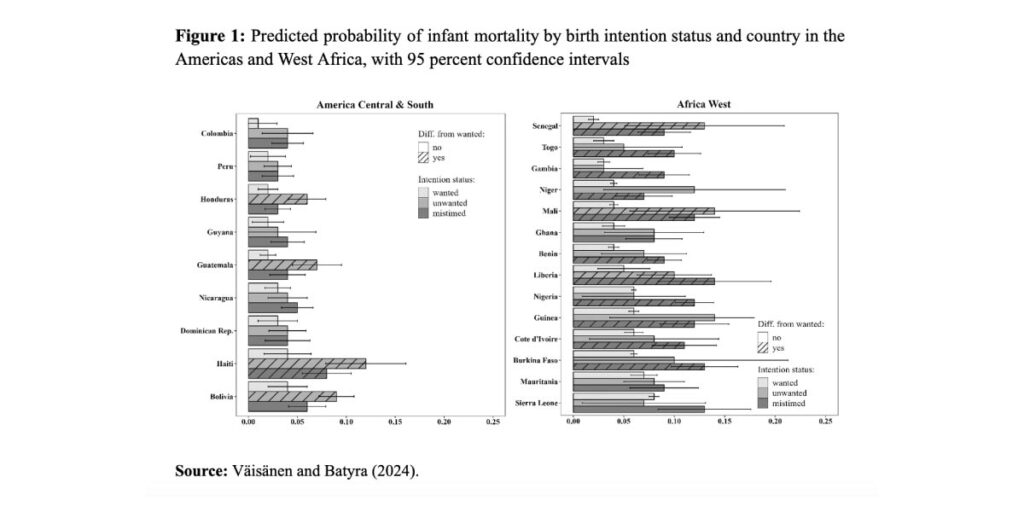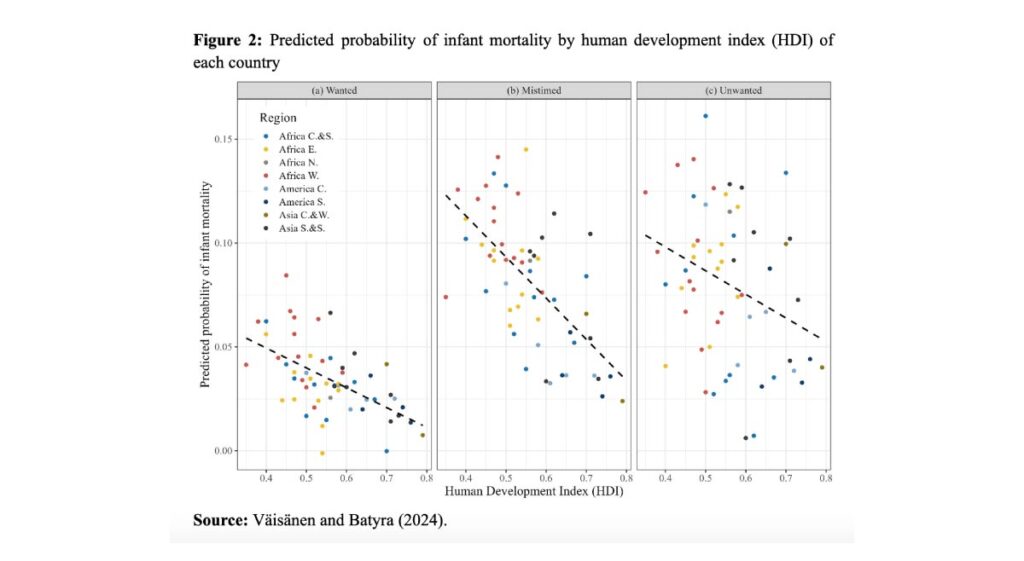Infant mortality after an unintended birth

There is a longstanding interest in understanding whether children born following unplanned pregnancy could be at higher risk of negative health outcomes, including early life mortality. Using Demographic and Health Surveys for 60 countries, Heini Väisänen and Ewa Batyra cast a new light on whether, and in which parts of the world, birth intentions matter for infant survival.
Although unintended pregnancy rates have globally decreased in the last decades, they remain high in some parts of the world, most notably in Africa and Latin America (Bearak et al. 2022). Thus, both researchers and policymakers continue to be interested in examining the consequences of unintended childbearing. Many studies have attempted to establish whether pregnancy intentions are important for children’s outcomes, but the empirical evidence so far has been inconsistent, in large part because it is difficult to separate the effect of pregnancy intentions from the sociodemographic characteristics typically associated with such intentions, and both may affect children’s well-being.
In a recent article, we examined the association between a mistimed birth (wanted later by the respondent) or an unwanted birth (the responded did not want any more children) and one of the key markers of health, namely infant mortality, across Asia, Africa and Latin America (Väisänen and Batyra 2024). Our approach differs from most previous studies on the topic in that we compared the survival chances of children born to the same mother, but differing in intention status, as reported by the mother. This modelling approach, called “fixed-effects”, allows us to automatically account for all the mother’s characteristics that do not change over time.
Birth intentions matter for infant mortality
We used data collected in Demographic and Health Surveys in 60 countries between 2000 and 2020 to analyse to what extent the likelihood of surviving to the first birthday differs by birth intention status within families; and whether this relationship depends on the wider societal context, as measured by the human development index (HDI).
The usual way to tackle this problem is to compare the destiny of children born to different mothers with different intentions, but this “between” (different mothers) approach makes it difficult to spot the true cause: is it intentions or is it mothers’ heterogeneity? Instead, we compared the destiny of children (of different birth orders, to be sure) born to the same mother, but not necessarily with the same intention each time (births desired, mistimed, or unwanted), as reported by the mothers themselves. With this “within” (same mother) approach, we can safely assume that intentions play a prominent part in the child’s destiny.
Our results show that in 41 countries out of 60, births that were unwanted or mistimed, or both, were associated with a higher likelihood of infant mortality, and that in none of the countries did wanted births have a higher likelihood of infant mortality than unintended births. This may be due to different behaviours during and after pregnancy, such as the use of antenatal care or breastfeeding; or the circumstances in which that child is born, such as birth interval, birth order and family resources after the birth of an additional child.
Mistimed births are different from unwanted births
Most previous studies have not distinguished between mistimed and unwanted births. However, we show that in many countries the association with infant mortality differs between the two groups. For example, Figure 1 shows that among all categories of birth intention status, unwanted pregnancies had the highest probability of infant mortality in the Americas, while this was more often the case for mistimed pregnancies in West Africa. These results cast new light on the variation in the consequences of pregnancy intentions and highlight that, in some settings, becoming pregnant too early, or too soon after a previous birth, may be equally or more disruptive than becoming pregnant when not wanting any more children.

Birth intention status matters more in contexts with a low human development index
We also examined whether the association between birth intention status and infant mortality varies by the level of “development” of each country. As is known, the probability of infant mortality decreases with the country’s HDI. This is true across all birth intention groups but the decline is strongest for mistimed births (Figure 2). These results suggest a particularly heavy mortality burden associated with mistimed pregnancies, which is magnified in contexts characterized by low HDI. Thus, children born following unintended pregnancies are disadvantaged when it comes to survival and this disadvantage is even larger in less developed settings. It is possible that as social, economic, and health conditions improve, it may be easier for women to deal with the difficulties arising from mistimed pregnancy and childbirth.

Conclusions
Children tend to have a higher risk of infant mortality if the pregnancy was unintended – even children (of different birth orders) born to the same mother. However, the strength of the association and the type of intention that matters the most (unwanted or mistimed pregnancy) depend on the context. Overall, these effects are more pronounced in contexts with lower levels of development, as measured by the HDI. This highlights the importance of conducting analyses at the finest possible territorial level (country rather than region) to better understand contextual differences. Also, it is important to distinguish between unwanted and mistimed births as they have different associations with infant mortality depending on context.
References
Bearak, J. M., Popinchalk, A., Beavin, C., Ganatra, B., Moller, A.-B., Tunçalp, Ö., & Alkema, L. (2022). Country-specific estimates of unintended pregnancy and abortion incidence: a global comparative analysis of levels in 2015–2019. BMJ Global Health, 7(3), e007151. https://doi.org/10.1136/bmjgh-2021-007151
Gipson, J. D., Koenig, M. A., & Hindin, M. J. (2008). The Effects of Unintended Pregnancy on Infant, Child, and Parental Health: A Review of the Literature. Studies in Family Planning, 39(1), 18–38. https://doi.org/10.1111/j.1728-4465.2008.00148.x
Väisänen, H., & Batyra, E. (2024). Birth Intention Status and Infant Mortality: Fixed-Effects Analysis of 60 Countries. Population and Development Review, Online first. https://doi.org/10.1111/padr.12652